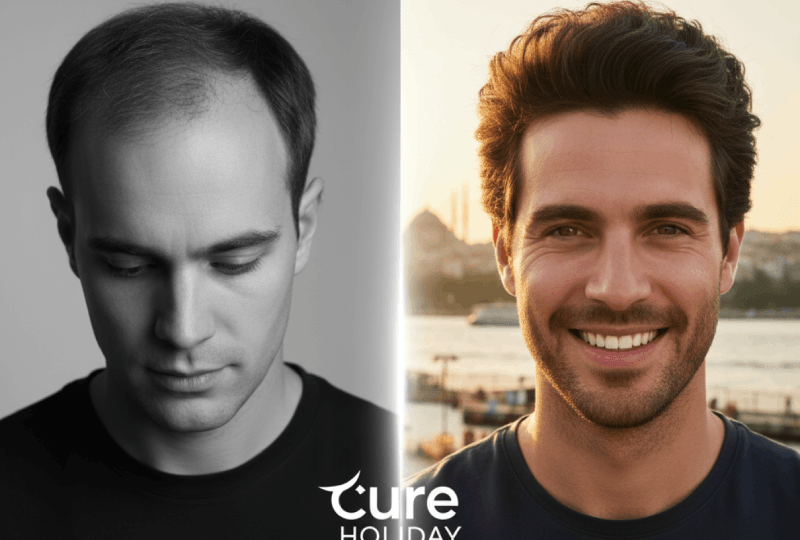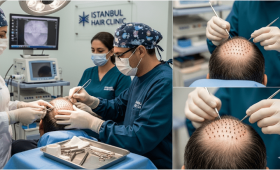Introduction: A Scientific Perspective on the Hair Transplant Procedure and the Report’s Purpose
Hair transplantation is a well-established reconstructive surgical procedure that offers an aesthetic and permanent solution for individuals experiencing hair loss. The fundamental principle of the procedure is to extract hair follicles (grafts) that are genetically resistant to balding, typically from the donor area at the back of the head, and transplant them to bald or thinning areas. When performed correctly with appropriate aftercare, this procedure helps individuals regain their natural hair appearance.
Instead of addressing the common but misleading question of “what is the best hair transplant technique,” this report provides a scientific and practical analysis of the current methods. Its purpose is to delve into the fundamental principles, application stages, advantages, and disadvantages of each technique, to highlight the crucial role of personal factors in the selection process, and to outline the potential risks of the operation and the importance of choosing the right clinic. The report serves as a guiding resource for an individual to determine the most suitable technique for their specific situation, in consultation with a specialist.
Section 1: Comprehensive Analysis of Current Hair Transplant Techniques
This section examines the operational principles, application stages, and fundamental differences of the most common and basic hair transplant methods: FUE, DHI, and FUT. The primary distinction between these techniques lies in how hair follicles are harvested from the donor area and implanted into the recipient area.
FUE (Follicular Unit Extraction) Technique
FUE is a modern hair transplant method where hair follicles are extracted one by one from the donor area using micro-surgical instruments. This procedure typically uses punches or micromotor devices with a diameter of 0.7-1 mm. The extracted hair follicles are kept in a solution before being individually transplanted into channels created with special instruments, such as steel blades, in the recipient area. This operation, which typically lasts 6 to 8 hours, is a procedure that can be applied to large areas.
One of the most significant advantages of the FUE technique is that it does not leave a linear incision scar in the donor area. Instead, it results in small, dot-like scars that fade over time, allowing the patient to wear their hair short. As a minimally invasive procedure, the recovery period is generally shorter, and the patient can return to their normal life within approximately 7-10 days. FUE also stands out for its low risk of complications. However, the FUE technique also has some disadvantages. It can take longer compared to other methods, and it is necessary to shave the donor area. If the micromotor settings are incorrect, it can damage the follicles in the donor area, which may prevent hair from growing. FUE can be used effectively not only for hair transplantation but also for smaller and more specific areas like eyebrows, mustaches, and beards.
DHI (Direct Hair Implantation) Technique
DHI is a technique where hair follicles are directly implanted into the recipient area using a special implanter pen called the Choi Pen. This technique uses the graft harvesting stage of the FUE method but combines the channel opening and implantation processes into a single movement. Unlike FUE, there is no pre-existing channel opening step. This approach minimizes the time the grafts are exposed to external factors, which can increase their survival rate.
Among the most significant advantages of DHI is the better control over the angle and direction of the hair follicles, thanks to the precision of the Choi Pen. This makes it possible to achieve more natural and dense results. The technique generally causes less bleeding and offers a faster recovery process. DHI is an aesthetically more comfortable option for patients, especially because there is no need to shave the hair. However, because the DHI technique requires a more delicate and lengthy procedure, the operation time can be extended. Since fewer grafts (1500-2000) can be transplanted in a single session compared to FUE, this limits its suitability for large bald areas.
FUT (Follicular Unit Transplantation) Technique
FUT is an older method where a strip of the scalp is surgically removed, and from this strip, individual grafts are separated under a microscope and transplanted to the recipient area. While this method can offer a shorter procedure time compared to FUE , it has aesthetic disadvantages due to leaving a permanent, linear scar in the donor area. Furthermore, the recovery period can exceed 15 days, and post-operative pain may be more pronounced compared to FUE. The emergence of more minimally invasive and aesthetically superior techniques like FUE has largely relegated FUT to the background, leading to this method being less frequently chosen today.
Looking at the evolution of these techniques, it is clear that the hair transplant industry is moving towards solutions that are less invasive, more aesthetically pleasing, and enhance patient comfort. The aesthetic disadvantages and lack of comfort of FUT directly increased the demand for FUE. Similarly, the precision offered by Sapphire FUE and DHI, in contrast to the potential damage from the channels opened by the micromotor in FUE, is a result of the quest for more natural-looking results.
Section 2: Innovative Sub-techniques and Application Tools
Innovative techniques and tools that refine and customize the main hair transplant methods play a critical role in achieving natural and successful results in hair restoration. These techniques are considered “implantation techniques” that improve upon the basic principles of the FUE method.
Sapphire FUE Technique: An Innovation Against Traditional FUE
Sapphire FUE is essentially a sub-type of the FUE method. In this technique, during the channel opening stage for the placement of hair follicles, special pens with tips made from real sapphire ore are used instead of metal steel slits. The use of sapphire tips offers a number of significant advantages over traditional FUE.
Sapphire tips, being sharper, smoother, and more precise than steel blades, cause less trauma to the skin. This accelerates the healing process and reduces the risk of infection and scabbing. Because sapphire blades can create smaller and smoother channels, they allow for more grafts to be implanted per square centimeter. This results in a denser and fuller appearance of the hair. Furthermore, the small channels opened make it easier to implant the hair at an angle closer to the natural 40-degree exit angle, preventing an artificial look. Sapphire FUE can be more costly than traditional FUE as it requires more advanced tools and expertise. However, for patients seeking faster recovery and superior aesthetic results, this additional cost can be seen as a worthwhile investment.
Lateral Slit and Choi Pen: Different Approaches to Channel Opening and Implantation
There are different approaches for the channel opening and implantation stages in hair transplantation. The Lateral Slit method involves creating incisions at horizontal angles in the hair transplant area using scalpels or sapphire tips specially prepared according to the thickness of the grafts. This approach allows for a denser and more natural placement of the hair follicles.
The Choi Pen (Implanter Pen) Technique, on the other hand, is a special tool used in the DHI technique that places the graft inside it and, by pressing it directly into the recipient area, both opens the channel and implants the graft in a single movement. This single action minimizes the graft’s exposure to external factors and prevents improper handling, thereby increasing the graft’s survival rate. While the Lateral Slit technique is notable for its ability to perform dense implantation , the Choi Pen offers the advantage of being less invasive and ensuring graft preservation. The shared goal of both methods is to minimize trauma to the scalp, thereby accelerating healing and increasing the survival of the transplanted follicles.
Section 3: Which Technique is Right for You? A Personalized Decision-Making Guide
It is not possible to speak of a single “best” technique for hair transplantation; the right approach is to determine the one that is most suitable for an individual’s specific situation. This decision requires a detailed evaluation of the following personal factors.
Assessment of Personal Factors
- Type and Severity of Hair Loss: FUE and Sapphire FUE may be more suitable for large bald areas and high graft counts (4000-7000 grafts). DHI, on the other hand, can be preferred for increasing density or filling in small areas (1500-2000 grafts).
- Condition and Quality of the Donor Area: The donor area (typically the back of the head) must have sufficient density and quality for a successful hair transplant. For patients with a weak donor area, FUE offers the advantage of graft extraction from other body parts.
- Hair Type: Fine or curly hair can make the implantation process more difficult. DHI’s ability to be applied to curly and fine hair follicles without causing damage can be an advantage for this patient group.
- Personal Expectations and Goals: For those who desire a natural hairline or high density, precise techniques like DHI or Sapphire FUE may be more suitable. Individuals who plan to wear their hair short should prefer FUE, which, unlike FUT, does not leave a linear scar.
Comparative Summary of Hair Transplant Techniques
The table below summarizes the key features and differences of the techniques discussed above.
| Feature | FUE | DHI | Sapphire FUE | FUT |
| Graft Extraction | Individual (Micromotor/Punch) | Individual (Micromotor/Punch) | Individual (Micromotor/Punch) | Strip |
| Channel Opening | Steel Blade | Choi Pen (simultaneous with implantation) | Sapphire Blade | None |
| Procedure Time | ~6-8 hours | ~6-8 hours | ~6-8 hours | ~5-7 hours |
| Recovery Time | 7-10 days | 10-14 days | 5-7 days | 15+ days |
| Scar Risk | Dot Scars | Dot Scars | Dot Scars | Linear Scar |
| Density & Naturalness | Low/Medium | High | High | Medium |
| Cost | Low/Medium | Medium/High | Medium/High | Low/Medium |
This table helps to clearly understand which metrics different techniques excel in by consolidating complex information into a single visual. Consequently, the answer to the question “which technique is right for you” is a multi-dimensional decision that combines an individual’s biological profile (donor area, hair type), expectations (density, scarlessness, recovery speed), and budget (cost). This demonstrates that there is no absolute “best” technique, but rather a most suitable one for each individual.
Section 4: Risks, Potential Side Effects, and the Recovery Process
Since hair transplantation is a surgical procedure, it involves certain risks and side effects. This process is not limited to the operation itself but also requires the patient to fully comply with pre- and post-operative instructions.
Common Side Effects and Their Management
- Scabbing and Itching: These are among the most common side effects after a hair transplant. Scabbing, a sign of the healing process, usually falls off on its own within 2 weeks. It is vitally important to avoid scratching during this period, as it can damage the newly transplanted follicles.
- Edema (Swelling): Swelling can occur on the forehead and around the eyes after the operation. This condition typically subsides within a week. Lying flat on your back or with a slight back support can help reduce the risk of edema.
- Shock Loss: This is a process that occurs 1-3 months after the transplant, where the transplanted hair temporarily falls out, which is considered completely normal. This condition is temporary and no cause for panic; new hair starts to grow in 3-4 months, and the final results are visible within 12-18 months.
Rare Complications
- Infection: The risk of infection increases in operations performed in non-sterile environments. Regular use of antibiotics after the surgery is of critical importance to minimize this risk.
- Scarring: FUE leaves minimal dot-like scars, whereas FUT results in a linear scar.
- Necrosis (Tissue Death): This is a very rare but serious complication caused by insufficient blood flow.
- Hiccups: Although rare, this can be a side effect resulting from nerve irritation during or after the procedure.
Post-operative Care and Follow-up
For a successful hair transplant, the patient’s care during the post-operative period is of vital importance. It is necessary not to bend the head in the first few days after the procedure , to avoid strenuous exercise , to cease alcohol and tobacco consumption , and to use the medication prescribed by the doctor regularly. The first wash is usually performed 48 hours after the operation, and it is recommended to protect the transplanted area from water and chemicals for the first week. It is essential to correctly understand the symptoms of the healing process and to consult a doctor in case of unusual conditions like high fever.
Section 5: The Importance of Choosing a Specialist and Clinic: A Case Study in Izmir
While technique selection is an important component of a successful hair transplant, the factor that has a more decisive impact on the ultimate success of the operation is the choice of the specialist and the clinic that will perform the procedure. Factors that directly affect aesthetic outcomes, such as proper hairline design, correct angling of the hair, and natural density of graft placement, depend entirely on the surgeon’s experience. The psychological and financial consequences of an unsuccessful operation can be severe.
An Assessment of Clinics and Doctors in Izmir
Patient feedback on hair transplant services in Izmir reveals how personal and careful a process this decision requires. For example, sources introduce Dr. Sibel Ulusan as one of Turkey’s first hair transplant doctors. She has gained international recognition with her self-developed channel opening technique and natural hairline designs. Patient reviews are overwhelmingly positive, highlighting the naturalness of the operation, the comfort provided, and the care of the expert team.
In contrast, while Özel Clinichair Polikliniği is stated to offer various techniques such as FUE, DHI, and CHI , there are both positive reviews praising successful results and negative complaints expressing disappointment with unsuccessful operations. This suggests that success rates may vary from person to person or that there may be inconsistencies in the clinic’s internal operations. Similarly, complaints about centers like Serena and Novar generally focus on other aesthetic procedures like laser hair removal or fillers rather than hair transplantation. This creates the impression that while these centers offer general aesthetic services, they may not be specialized in the field of hair transplantation.
This conflicting data indicates that a well-informed decision-making process should focus on the individual experience, skill, and history of the surgeon who will perform the operation, rather than on the clinic’s brand. Successful outcomes are often directly associated with the name of the expert physician, while reports of failure are more often directed at the clinic as a whole.
Action-Oriented Guide: A Checklist for Choosing the Best Specialist
Choosing the right specialist for a hair transplant is one of the most critical steps for the operation’s success. Potential patients are advised to follow these steps in the process:
- Verify Specialization: Ensure that the person performing the procedure is a Plastic Surgery Specialist or a Dermatologist. Inquire about their expertise and experience in hair restoration and check for certifications such as membership in an international society (ISHR).
- Request a Personalized Plan: Ask if a specific hair transplant plan has been created for you.
- Find Out Who Performs the Operation: Clarify whether the entire operation or its crucial stages will be performed by the surgeon themselves or by technicians.
- Conduct Comprehensive Research: Examine not only the reviews on the clinics’ own websites but also comments on independent complaint platforms.
Conclusion: The Best Method is the Right One for You
This report has thoroughly examined the core features, advantages, and disadvantages of the most common hair transplant techniques: FUE, DHI, Sapphire FUE, and FUT. The analysis shows that FUT has been replaced by FUE due to its aesthetic drawbacks, while DHI and Sapphire FUE are techniques that bring greater precision and superior aesthetic results in addition to the minimal invasiveness offered by FUE.
The “best” hair transplant technique is a dynamic concept that changes depending on an individual’s type of hair loss, the condition of their donor area, and their personal expectations. The success of a hair transplant operation depends far more on the expertise and experience of the professional performing the procedure than on the technique chosen. The foundation of a conscious decision-making process is selecting a professional who is an expert and experienced in the field, working in a sterile environment. This is an indispensable condition for success and patient satisfaction.
Unlocking Your Confidence with a Hair Transplant in Turkey: An Exclusive Offer from Cure Holiday
Have you been thinking about getting your hair back, but you’re not sure where to start? A hair transplant can be a life-changing experience, and Turkey has become the number one destination for this popular cosmetic procedure. With advanced techniques and experienced surgeons, it’s easier and more affordable than ever to restore your hair and your confidence.
At Cure Holiday, we specialize in making this journey simple, safe, and stress-free. We believe that everyone deserves to feel their best, and our all-inclusive packages are designed to give you a premium experience without the premium price tag.
Why Choose Cure Holiday?
- Experienced Doctors: Our partner clinics work with some of Turkey’s most skilled and reputable surgeons, ensuring you’re in expert hands from start to finish.
- All-Inclusive Comfort: Forget about the hassle of planning. Our packages cover everything: your flights, 5-star hotel stay, airport transfers, and even a dedicated host to guide you through every step of your treatment.
- Cutting-Edge Techniques: We offer the latest hair transplant methods, including FUE (Follicular Unit Extraction) and DHI (Direct Hair Implantation), giving you natural, permanent results with minimal scarring.
- Unbeatable Value: Thanks to Turkey’s lower operational costs, we can provide world-class quality at a fraction of the price you’d pay in the UK, USA, or Europe.
Your New Look is Closer Than You Think
Ready to take the first step toward a new you? Contact us today for a free consultation. Our team is here to answer all your questions and help you customize a plan that’s perfect for you.
Don’t let another day go by wishing for the hair you used to have. Let Cure Holiday help you get it back, with an exclusive offer you won’t find anywhere else.



